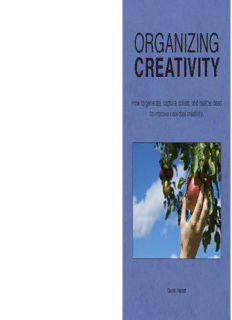
by making the first edition available again as PDF - Organizing PDF
Preview by making the first edition available again as PDF - Organizing
O Bring more structure in your creativity: R ORGANIZING Organize it. G CREATIVITY A About this Book N This book was written as a help for individual persons who want to organize their creativity, be it for science (incl. engineering and commercial projects), art or private projects. Its aim is to enlarge your options when having ideas and to improve the chance of realizing creative I projects. Z How to generate, capture, collect, and realize ideas It is written as a practical handbook and describes how organization can support generating, capturing, collecting (incl. enlarging, restructuring, etc.) and realizing ideas. I to improve individual creativity. N While creativity “techniques” are dealt with, the focus is on the infrastructure to enable you to capture your fleeting ideas and cultivate them to finally realize them as creative projects. G Contents 1. About Creativity Definition, Misconceptions, Advantages & Disadvantages, Responsibility, Requirements for Creativity, and Helpful Skills C 2. Creativity and Organization Benefits of Organizing Creativity, Apparent Exceptions, Principles and Starting to Organize, and Organizing Yourself R 3. Generating Ideas The Creative Process, Hard Work & Time (I), Blocks, Techniques & Tactics, and Finding Problems E 4. Capturing Ideas Reasons, Ways, Evaluating Capturing Methods, Quality of Tools, Missed Ideas, Specific Ways to Capture, Worst Cases, Nothing to Capture, Other People, and Scenarios A 5. Collecting Ideas Reasons, Ways, Organizing the Idea Collection, Prioritizing, Evaluating Collection Methods, Ways of Collecting Ideas, Issues, Starting, Digitalizing Information, Expanding, Restructuring and Removing, and Protecting the Collection T 6. Realizing Ideas Harvest, Selecting Ideas for Realization, Hard Work & Time (II), Process of Realizing Ideas, Organizational Helps, Problems in the Realization Phase, Feedback, Communicating I Ideas, Worst Cases, and Best Case V 7. Archiving Ideas Reasons, Ways, Problems, and Other Aspects I 8. Final Remarks & Appendix Final Remarks, Contact Information, Links Index, and a Short T History of this Book Y Organizing creativity is similar to keeping an orchard: you prepare the ground (acquire knowledge and skills), you plant (put captured ideas in the idea collection) and raise (add to, enlarge and restructure the ideas) your culture (projects). Finally when a Daniel Wessel project is ripe (has sufficient ideas) you can harvest it (realize the project) and enjoy the fruits of success. Organizing Creativity How to generate, capture, collect, and realize ideas to improve individual creativity. I would like to thank … … the muses who inspired me to write this book. … Keith Blount and his team for the “Scrivener” writing software. … the programmers of Circus Ponies Notebook and DokuWiki. … the organizers of the MinD-Akademie 2007. … the participants of my explorative survey about the organization of individual creativity. … all critics who gave me feedback to improve this work. … Tanja Gabriele Baudson for the interesting stimulations. … Eva Maria Reussner for her valuable feedback and for agreeing to be the hand model on the cover of this book. Thank you. © 2009 by Daniel Wessel. All rights reserved. Cover Image: Copyright by Daniel Wessel, 2008. I know that scanning a book and sharing it online makes it instantly available and is a nice way to promote oneself and to ‘help’ others, but please refrain from doing so. This book took me over a year and a half of my life to write, time I will not get back. While (essentially) stealing a book might be regarded as a compliment by some as a sign that my work is appreciated, I actually prefer money. If you got an illegal copy, please consider making a donation. You find my address at www.organizingcre- ativity.com or at www.ipsych.org. Cite as: Wessel, D. (2009). Organizing Creativity. To all muses, inspiring us. Table of Contents Introduction 1 Overview of the contents of this book 5 Disclaimers 6 About the Author 7 Sources 8 Aims of this book 9 Creativity 13 What is Creativity? 15 Misconceptions About Creativity 25 Advantages and Disadvantages of Creativity 32 Responsibility 36 What is needed to be creative? 40 What is not needed for creativity? 53 Helpful Skills 57 Creativity and Organization 59 Why Organize Creativity? 61 Creativity without Organization? 66 How to Organize Creativity 68 Starting to Organize Creativity 71 Organize Yourself 73 Generating Ideas 77 The Creative Process 79 A Case for Hard Work 81 A Case for Time 91 Blocks 97 Techniques and Tactics 98 Finding Problems 127 Table of Contents Capturing Ideas 129 Why capture ideas? 131 How to capture ideas 135 Evaluating an Idea Capturing Method 141 The quality of tools for capturing ideas 143 Missed Ideas 145 Ways to Capture Ideas 146 Worst Cases in Capturing Ideas 162 When you have nothing to capture 164 Capturing Hell is other people 166 Capturing Ideas Scenarios 168 Collecting Ideas 183 Why Collect Ideas? 185 How to collect ideas 187 Organizing the idea collection 197 Prioritize Projects 207 Remembering Central Projects via Landmines 210 Evaluating an Idea Collection 213 Ways of Collecting 222 Some Issues regarding the ways of collecting ideas 256 Starting an Idea Collection 257 Digitalizing Information 259 Finding Ideas 260 Expanding Ideas 261 Restructuring Ideas 262 Removing Ideas 264 Protecting your Idea Collection 265 Realizing Ideas 277 Harvest! 279 How to decide which idea to realize 280 viii Table of Contents A case for hard work (Part II) 285 A case for time (Part II) 288 How to realize ideas 290 Organizational Helps 297 Problems during the realization phase 299 Feedback 305 Communicating Ideas 328 Worst Cases 341 Success 359 Archiving Ideas 361 Why archive projects? 363 How to archive projects 364 Problems of Archives 367 Other Aspects of Archives 369 Final Remarks & Appendix 371 Final Remarks 373 Contact the Author 375 Link Index 377 ix
Description: